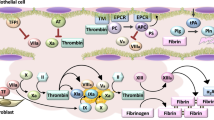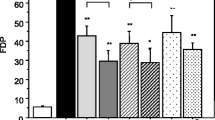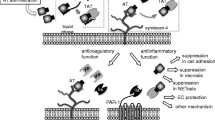Abstracts
Antithrombin is expected to modulate both prothrombotic and proinflammatory reactions in sepsis; vascular endothelium is the primary target. In the present study, we sought to evaluate the protective effects of a newly developed fucose-deficient recombinant antithrombin. Endothelial cells were treated in vitro with histone H4 to induce cellular damage. Low to high doses of either plasma-derived antithrombin or recombinant thrombomodulin were used as treatment interventions. Morphological change, apoptotic rate, cell viability, cell injury, and syndecan-4 level in the medium were evaluated. Immunofluorescent staining with anti-syndecan-4 was also performed. Both types of antithrombin reduced cellular damage and apoptotic cell death. Both plasma-derived and recombinant antithrombin improved cell viability and reduced cellular injury when administered at a physiological concentration or higher. Syndecan-4 staining became evident after treatment with histone H4, and both antithrombins suppressed the staining intensity at similar levels. The syndecan-4 level in the medium was significantly decreased by both antithrombins. None of the indicators showed a significant difference between plasma-derived and recombinant antithrombin. In conclusion, both recombinant and plasma-derived antithrombin can protect vascular endothelial cells. Recombinant antithrombin may represent a useful new therapeutic agent for sepsis-associated vascular damage.




Similar content being viewed by others
References
Bucur SZ, Levy JH, Despotis GJ, Spiess BD, Hillyer CD. Uses of antithrombin III concentrate in congenital and acquired deficiency states. Transfusion. 1998;38:481–98.
Quinsey NS, Greedy AL, Bottomley SP, Whisstock JC, Pike RN. Antithrombin: in control of coagulation. Int J Biochem Cell Biol. 2004;36:386–9.
Levy JH, Sniecinski RM, Welsby IJ, Levi M. Antithrombin: anti-inflammatory properties and clinical applications. Thromb Haemost. 2016;115:712–28.
Iba T, Thachil J. Present and future of anticoagulant therapy using antithrombin and thrombomodulin for sepsis-associated disseminated intravascular coagulation: a perspective from Japan. Int J Hematol. 2016;103:253–61.
Franzén LE, Svensson S, Larm O. Structural studies on the carbohydrate portion of human antithrombin III. J Biol Chem. 1980;255:5090–3.
Mizuochi T, Fujii J, Kurachi K, Kobata A. Structural studies of the carbohydrate moiety of human antithrombin III. Arch Biochem Biophys. 1980;203:458–65.
Brennan SO, George PM, Jordan RE. Physiological variant of antithrombin-III lacks carbohydrate sidechain at Asn 135. FEBS Lett. 1987;219:431–6.
Turk B, Brieditis I, Bock SC, Olson ST, Björk I. The oligosaccharide side chain on Asn-135 of alpha-antithrombin, absent in beta-antithrombin, decreases the heparin affinity of the inhibitor by affecting the heparin-induced conformational change. Biochemistry. 1997;36:6682–91.
McCoy AJ, Pei XY, Skinner R, Abrahams JP, Carrell RW. Structure of beta-antithrombin and the effect of glycosylation on antithrombin’s heparin affinity and activity. J Mol Biol. 2003;326:823–33.
Martínez-Martínez I, Navarro-Fernández J, Østergaard A, Gutiérrez-Gallego R, Padilla J, Bohdan N, et al. Amelioration of the severity of heparin binding antithrombin mutations by posttranslational mosaicism. Blood. 2012;120:900–4.
Fan B, Crews BC, Turko IV, Choay J, Zettlmeissl G, Gettins P. Heterogeneity of recombinant human antithrombin III expressed in baby hamster kidney cells. Effect of glycosylation differences on heparin binding and structure. J Biol Chem. 1993;268:17588–96.
Garone L, Edmunds T, Hanson E, Bernasconi R, Huntington JA, Meagher JL, et al. Antithrombin-heparin affinity reduced by fucosylation of carbohydrate at asparagine 155. Biochemistry. 1996;35:8881–9.
Olson ST, Frances-Chmura AM, Swanson R, Björk I, Zettlmeissl G. Effect of individual carbohydrate chains of recombinant antithrombin on heparin affinity and on the generation of glycoforms differing in heparin affinity. Arch Biochem Biophys. 1997;341:212–21.
Yamane-Ohnuki N, Kinoshita S, Inoue-Urakubo M, Kusunoki M, Iida S, Nakano R, et al. Establishment of FUT8 knockout Chinese hamster ovary cells: an ideal host cell line for producing completely defucosylated antibodies with enhanced antibody-dependent cellular cytotoxicity. Biotechnol Bioeng. 2004;87:614–22.
Stanley P, Chaney W. Control of carbohydrate processing: the lec1A CHO mutation results in partial loss of N-acetylglucosaminyltransferase I activity. Mol Cell Biol. 1985;5:1204–11.
Yamada T, Kanda Y, Takayama M, Hashimoto A, Sugihara T, Satoh-Kubota A, et al. Comparison of biological activities of human antithrombins with high-mannose or complex-type nonfucosylated N-linked oligosaccharides. Glycobiology. 2016;26:482–92.
Wada H, Asakura H, Okamoto K, Iba T, Uchiyama T, Kawasugi K, et al. Expert consensus for the treatment of disseminated intravascular coagulation in Japan. Thromb Res. 2010;125:6–11.
Ishiyama M, Tominaga H, Shiga M, Sasamoto K, Ohkura Y, Ueno K. A combined assay of cell viability and in vitro cytotoxicity with a highly water-soluble tetrazolium salt, neutral red and crystal violet. Biol Pharm Bull. 1996;19:1518–20.
Hirose M, Kameyama S, Ohi H. Characterization of N-linked oligosaccharides attached to recombinant human antithrombin expressed in the yeast Pichia pastoris. Yeast. 2002;19:1191–202.
Schouten M, Wiersinga WJ, Levi M, van Der PT. Inflammation, endothelium, and coagulation in sepsis. J Leukoc Biol. 2008;83:536–45.
Weinbaum S, Tarbell JM, Damiano ER. The structure and function of the endothelial glycocalyx layer. Annu Rev Biomed Eng. 2007;9:121–67.
Reitsma S, Slaaf DW, Vink H, van Zandvoort MA, oude Egbrink MG. The endothelial glycocalyx: composition, functions, and visualization. Pflugers Arch. 2007;454:345–59.
Ishiguro K, Kadomatsu K, Kojima T, Muramatsu H, Iwase M, Yoshikai Y, et al. Syndecan-4 deficiency leads to high mortality of lipopolysaccharide-injected mice. J Biol Chem. 2001;276:47483–8.
Chaaban H, Keshari RS, Silasi-Mansat R, Popescu NI, Mehta-D’Souza P, Lim YP, et al. Inter-α inhibitor protein and its associated glycosaminoglycans protect against histone-induced injury. Blood. 2015;125:2286–96.
Chappell D, Jacob M, Hofmann-Kiefer K, Rehm M, Welsch U, Conzen P, et al. Antithrombin reduces shedding of the endothelial glycocalyx following ischaemia/reperfusion. Cardiovasc Res. 2009;83:388–96.
Kaneider NC, Förster E, Mosheimer B, Sturn DH, Wiedermann CJ. Syndecan-4-dependent signaling in the inhibition of endotoxin-induced endothelial adherence of neutrophils by antithrombin. Thromb Haemost. 2003;90:1150–7.
Becker BF, Chappell D, Bruegger D, Annecke T, Jacob M. Therapeutic strategies targeting the endothelial glycocalyx: acute deficits, but great potential. Cardiovasc Res. 2010;87:300–10.
Longley RL, Woods A, Fleetwood A, Cowling GJ, Gallagher JT, Couchman JR. Control of morphology, cytoskeleton and migration by syndecan-4. J Cell Sci. 1999;112:3421–31.
Woods A, Couchman JR. Syndecan 4 heparan sulfate proteoglycan is a selectively enriched and widespread focal adhesion component. Mol Biol Cell. 1994;5:183–92.
Couchman JR. Transmembrane signaling proteoglycans. Annu Rev Cell Dev Biol. 2010;26:89–114.
Iba T. Glycocalyx regulates the intravascular hemostasis. Juntendo Med J. 2016;62:444–9.
De Jong MC, Walstra CM. Immunofluorescent localization of antithrombin III in human skin. Br J Dermatol. 1982;106:281–5.
Acknowledgements
This work was supported by the fund from Ministry of Education, Culture, Sports, Science and Technology-Supported Program for the Strategic Research Foundation at Private Universities 2016. All the authors have read and approved the final manuscript.
Author information
Authors and Affiliations
Corresponding author
Ethics declarations
Conflict of interest
The authors have no competing interests to declare.
Electronic supplementary material
Below is the link to the electronic supplementary material.
12185_2018_2402_MOESM1_ESM.pptx
Supplement 1. Time-course and dose–response of cell viability after treatment with histone H4. Vascular endothelial cell viability was measured based on the CCK-8 level in the culture medium. Cell viability started to decrease 6 h after the treatment with histone H4, and the level decreased in a dose-dependent manner. Cell viability was decreased nearly half of the initial level when the dose was 50 μg/mL. Data are expressed as the mean ± standard error. CCK-8: cell counting kit-8 (PPTX 94 kb)
12185_2018_2402_MOESM2_ESM.ppt
Supplement 2. SDS-PAGE for various types of antithrombin. The cathode (-) is located at the top of the gel (pH4), while the anode (+) is at the bottom (pH6.5). Fifteen micrograms of protein was loaded in each lane of either 20% or 7.5% (w/v) acrylamide gel. Each protein band was stained with Coomassie Brilliant Blue. Both α- and β-antithrombin were recognized as blue bands located near 58 kDa. In contrast, AT-γ was recognized as wider bands. SDS-PAGE: Sodium dodecyl sulfate–polyacrylamide gel electrophoresis, α-AT: α-antithrombin, β-AT: β-antithrombin, Pd-AT: plasma-derived antithrombin, AT-γ: antithrombin-γ (PPT 589 kb)
About this article
Cite this article
Iba, T., Hirota, T., Sato, K. et al. Protective effect of a newly developed fucose-deficient recombinant antithrombin against histone-induced endothelial damage. Int J Hematol 107, 528–534 (2018). https://doi.org/10.1007/s12185-018-2402-x
Received:
Revised:
Accepted:
Published:
Issue Date:
DOI: https://doi.org/10.1007/s12185-018-2402-x




